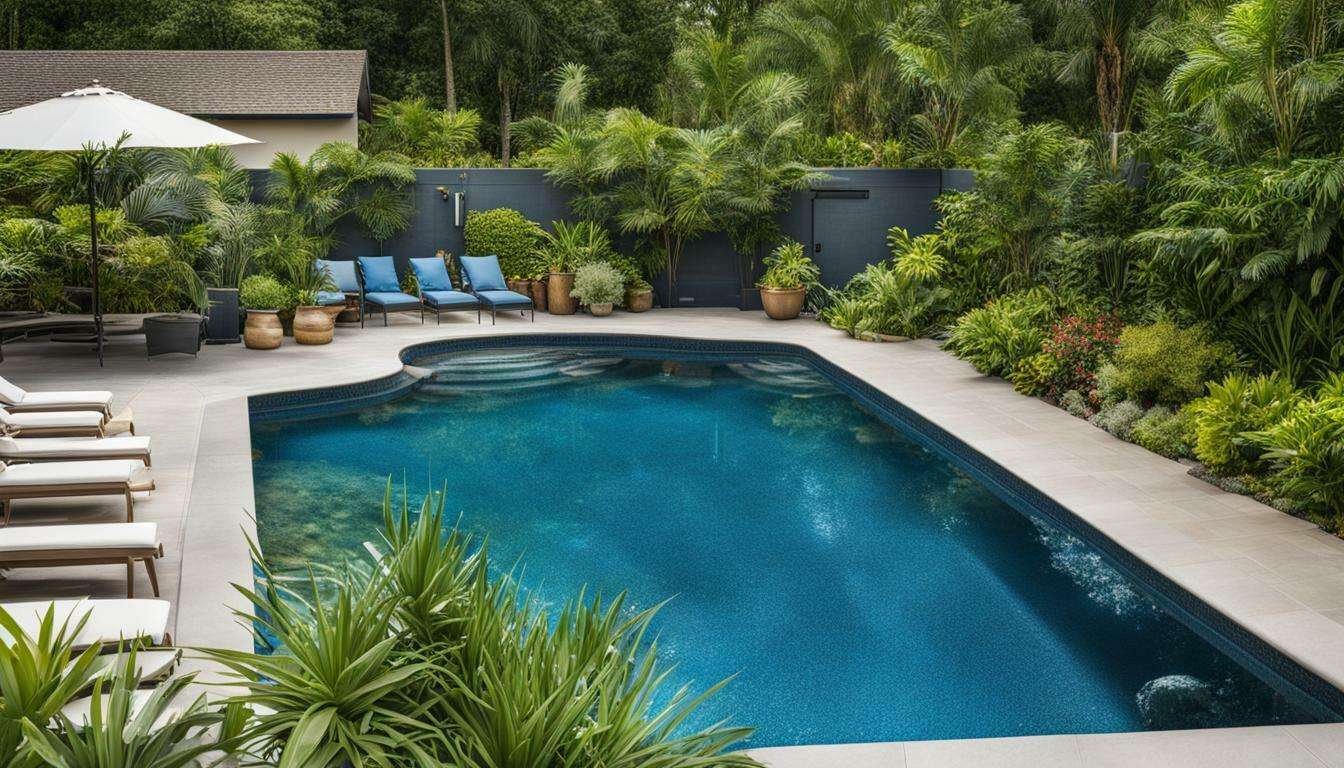Welcome to our comprehensive yearly pool maintenance guide for South Africa. Maintaining your pool is essential to keep it clean and beautiful year-round. By following these tips and incorporating them into a regular cleaning routine, you can ensure a clean and inviting pool throughout the year. In this guide, we will cover essential pool cover care tips to protect your pool from debris and maintain water temperature. Additionally, we will discuss the importance of regular water testing and chemical balancing to ensure a safe and healthy swimming environment. Follow these maintenance tips to enjoy a sparkling and well-maintained pool all year long.
Key Takeaways:
- Daily cleaning is crucial for removing leaves and debris from the pool. Consider using a pool cover to reduce cleaning frequency.
- Invest in a quality pool cleaner to remove algae and regularly scrub the pool to prevent algae build-up.
- Backwash the filter weekly and perform a manual backwash every six months for proper maintenance.
- Regularly check and adjust chemical levels in the pool to ensure proper balance and cleanliness.
- Schedule a yearly service appointment to check the pool’s mechanical equipment and winterize the pool to prevent damage.
Daily Cleaning and Debris Removal
Keeping your pool clean on a daily basis is crucial to prevent debris build-up and maintain a sparkling swimming area. By following a few simple pool cleaning tips and incorporating them into your regular maintenance routine, you can enjoy a pristine pool all year round.
Start by scooping out leaves and debris from the water’s surface using a pool net or skimmer. This will help prevent them from sinking to the bottom and potentially clogging the pool filter. Additionally, clear out the basket located near the pool pump to ensure proper water flow and prevent damage to the system.
If you’re looking to reduce the frequency of cleaning, consider using a pool cover. This will help keep leaves and debris out of the water when the pool is not in use. However, it’s still important to perform daily skimming to remove any floating debris that may have accumulated.
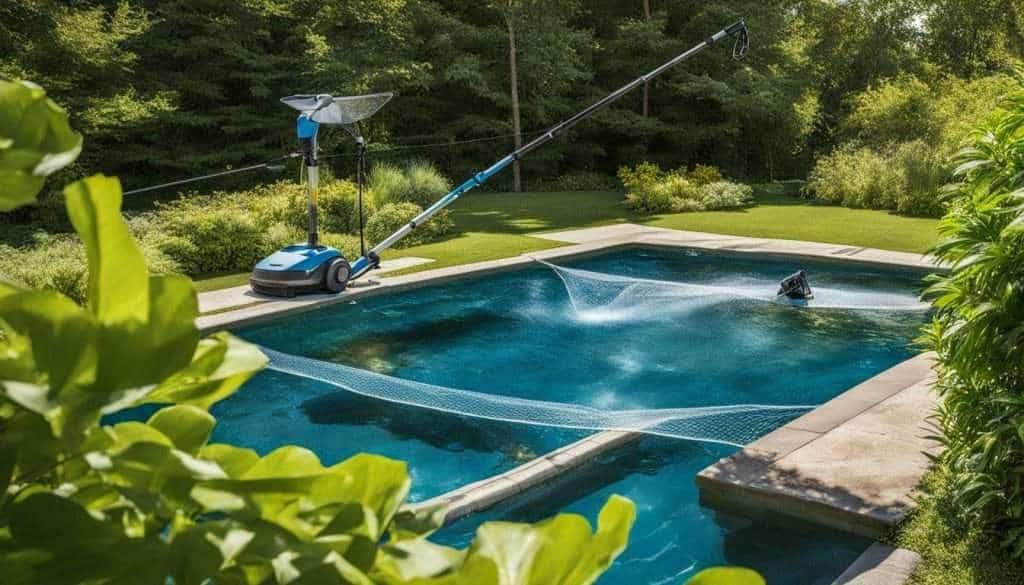
Remember, regular cleaning and debris removal are essential for maintaining a healthy and inviting swimming environment. Make it a part of your daily routine to keep your pool looking its best.
Algae Prevention and Treatment
Algae can quickly turn your pool from clear to green, but with the right preventive measures and proper treatment, you can keep your pool algae-free. Regular maintenance and a few simple steps can help you maintain a healthy and sparkling pool year-round.
To prevent algae growth, it’s essential to invest in a decent pool cleaner. It will efficiently remove any debris and small particles from the water, eliminating potential food sources for algae. Additionally, daily scrubbing of the pool walls and floor can disrupt algae growth and prevent it from taking hold.
During the summer months, it’s crucial to use algaecide regularly. Adding algaecide to your pool water helps to inhibit algae growth and keeps your pool water crystal clear. Follow the instructions on the algaecide bottle or consult with a pool maintenance professional to determine the appropriate amount for your pool size.
| Algae Prevention and Treatment Tips: |
|---|
| Invest in a decent pool cleaner to remove debris and particles that algae feed on. |
| Scrub the pool walls and floor daily to disrupt algae growth. |
| Use algaecide regularly during the summer months to inhibit algae growth. |
Remember, prevention is key when it comes to algae. By incorporating these preventative measures into your regular pool maintenance routine, you can enjoy a clean and algae-free pool all year long.

Conclusion
Regular maintenance and preventive measures are crucial for keeping your pool algae-free. By following the tips outlined in this guide, from investing in a pool cleaner to using algaecide and performing daily cleaning, you can ensure a sparkling and inviting pool for years to come. Don’t neglect the importance of maintaining proper chemical levels and performing routine filter maintenance. With a little effort and attention, you can enjoy your pool to the fullest without the worry of algae taking over.
Filter Maintenance
Proper maintenance of your pool filter is essential to ensure clean and clear water. Regular backwashing and occasional manual backwashing are crucial steps in keeping your filter functioning optimally. Here are some pool maintenance tips to help you maintain your filter:
- Backwash the filter weekly: Backwashing is the process of cleaning the filter by reversing the flow of water through it, flushing out debris and contaminants. It helps to remove trapped particles and keeps the filter operating efficiently. Make sure to follow the manufacturer’s instructions for your specific filter type.
- Perform a manual backwash and open up the sand filter every six months: In addition to regular backwashing, it is important to perform a manual backwash and open up the sand filter every six months. This allows for a deeper clean and helps to remove any accumulated debris that may not have been flushed out during regular backwashing.
- Check the filter pressure: Monitoring the filter pressure is a good indicator of when it needs to be cleaned. As the filter becomes clogged with dirt and debris, the pressure will increase. If you notice a significant increase in pressure, it’s time to backwash the filter.
Remember, maintaining your filter is just one part of overall pool maintenance. Regularly checking chemical levels, skimming debris off the water’s surface, and scrubbing the pool sides are also important tasks to keep your pool in top condition. By incorporating these maintenance tips into your routine, you can enjoy a clean and well-maintained pool year-round.
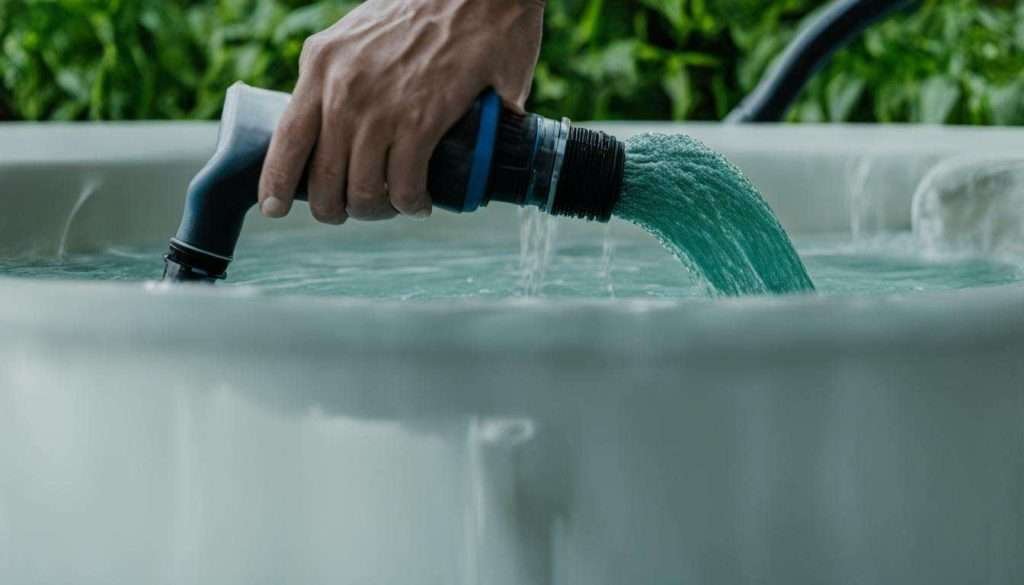
| Pool Maintenance Tips: | Pool Maintenance Schedule: |
|---|---|
| Backwash the filter weekly | Regularly |
| Perform a manual backwash and open up the sand filter every six months | Twice a year |
| Check the filter pressure | Regularly |
Pump and Impeller Inspection
Regular inspection of your pool pump and impeller is necessary to identify any potential problems early on and ensure proper water circulation. By taking the time to inspect these components, you can prevent costly repairs and maintain the health of your pool.
Start by checking for any blockages in the pump and impeller. Clear out any debris that may be obstructing the flow of water. Look for signs of wear or damage, such as cracked impellers or loose connections. Addressing these issues promptly will help maintain the efficiency of your pool system.
If you notice declining water levels in your pool, this could indicate a water leak. Inspect the pump and impeller for any signs of leakage or dripping. Addressing a water leak early on will help prevent further damage to your pool and save you money in the long run.
Remember to consult your pool maintenance schedule to determine how often you should inspect the pump and impeller. Regular maintenance will extend the lifespan of your pool equipment and ensure that your pool stays in optimal condition.
Table: Pool Pump and Impeller Inspection Checklist
| Inspection Item | Frequency |
|---|---|
| Clear out debris from pump and impeller | Weekly |
| Check for signs of wear or damage | Monthly |
| Inspect for water leakage or dripping | Monthly |
By incorporating regular pump and impeller inspections into your pool maintenance routine, you can ensure that your pool operates at peak performance and enjoy a clean and healthy swimming environment.
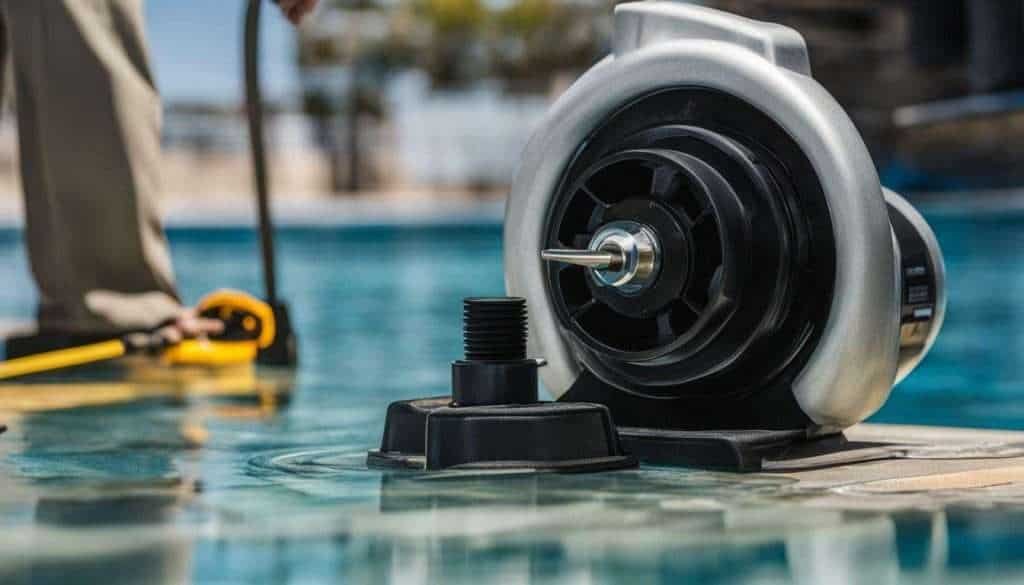
Surface Skimming and Algae Prevention
Skimming the water’s surface and scrubbing the pool sides are crucial tasks to maintain a clean and inviting pool. Regular skimming helps remove leaves, debris, and other floating particles, preventing them from sinking to the bottom and creating an unkempt appearance. Using a pool skimmer or net, gently glide the tool across the surface, collecting any unwanted objects. This simple practice, when performed daily, can significantly reduce the amount of manual cleaning required.
In addition to skimming, it’s essential to routinely scrub the pool sides to prevent algae growth and maintain a pristine appearance. Algae can quickly multiply and spread in pool water, turning it green and making it unsafe for swimming. To keep algae at bay, use a pool brush to scrub the walls and floor of the pool. Focus on areas where algae commonly accumulates, such as corners, steps, and crevices. This regular maintenance will help remove any existing algae and prevent it from returning.
Remember, prevention is key when it comes to algae. Maintain appropriate chemical levels, such as free chlorine and pH, to create an environment that inhibits algae growth. Regularly shock the pool to kill bacteria and prevent algae from taking hold. Additionally, consider using algaecide during peak swimming season as an extra layer of protection against algae.
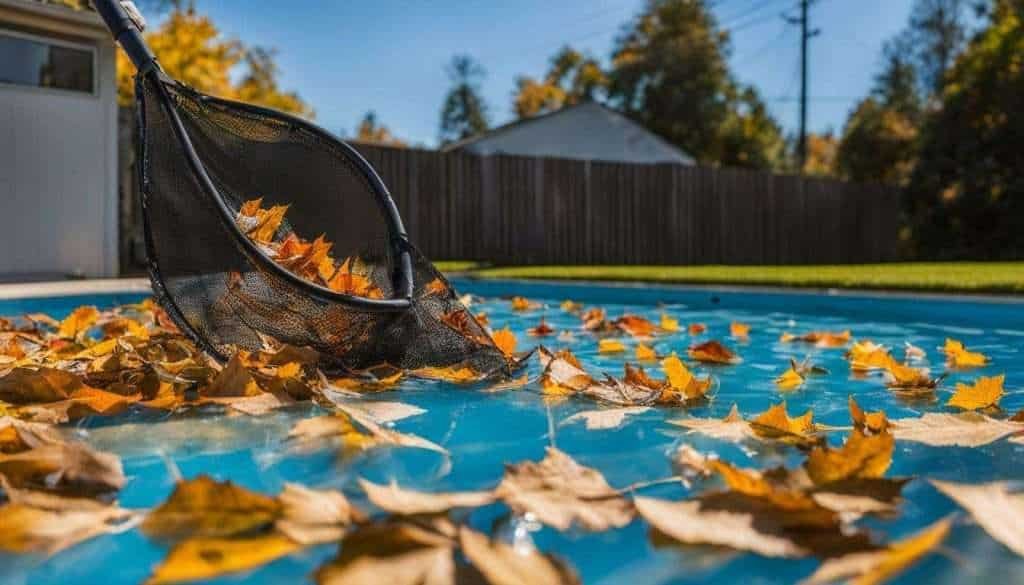
By incorporating these surface skimming and algae prevention practices into your regular pool maintenance routine, you can enjoy a clean and inviting pool all year round. Not only will it enhance the visual appeal of your pool, but it will also contribute to a healthier swimming environment for you and your family.
Chemical Levels and Balance
Maintaining proper chemical levels in your pool is vital for water quality and the overall health of swimmers. By regularly testing and adjusting the chemical levels, you can ensure that your pool remains safe, clean, and inviting.
Here are the key chemical levels to monitor and the recommended ranges:
| Chemical | Recommended Range |
|---|---|
| Cyanuric Acid | 30-50 ppm |
| Free Chlorine | 1-3 ppm |
| Acidity and Alkalinity | pH: 7.4-7.6 Alkalinity: 80-120 ppm |
| Total Alkalinity | 80-120 ppm |
| Calcium Hardness | 200-400 ppm |
To maintain these levels, you can use test strips or a liquid test kit to regularly check the chemical balance in your pool water. If any of the levels are outside the recommended range, you will need to make adjustments.
Keep in mind the following tips:
- Use baking soda to control alkalinity and raise pH levels if necessary.
- Shock the pool twice every season to kill bacteria and remove contaminants.
- Maintain the water level halfway up the skimmer opening to ensure proper filtration.
- Use a tennis ball in the pool to absorb oils left behind by swimmers and prevent water cloudiness.
- Power wash the pool deck regularly to remove stains that can affect water quality.
By following these guidelines and incorporating them into your pool maintenance routine, you can enjoy a crystal-clear pool that is safe and inviting for all swimmers.

Additional Maintenance Tips and Yearly Service
In addition to regular maintenance tasks, there are some additional tips to keep your pool in top condition. These tips will help you maintain the cleanliness and functionality of your pool throughout the year.
Firstly, scheduling a yearly service appointment with a professional pool maintenance company is crucial. They will inspect your pool’s mechanical equipment, such as the pump, filter, and heater, ensuring that everything is in proper working order. This preventative measure can help identify any potential issues early on, saving you from costly repairs in the future.
Properly winterizing your pool is another important step in maintaining its longevity. Before winter sets in, it’s essential to clean and balance the water chemistry, remove any debris, and lower the water level. Adding a winterizing chemical and covering the pool with a winter cover will protect it from the harsh elements, preventing damage and making the reopening process much easier.
By incorporating these additional maintenance tips into your regular pool care routine, you can ensure a clean and inviting pool all year round. Remember to stay consistent with your cleaning and chemical balancing, and don’t hesitate to seek professional help when needed. Enjoy a refreshing swim in your well-maintained pool!
FAQ
What should be included in a daily cleaning routine for a pool?
Daily cleaning should include scooping out leaves and debris, clearing out the basket, and considering the use of a pool cover to reduce the frequency of cleaning.
How can I prevent and treat algae in my pool?
To prevent and treat algae, it is recommended to invest in a decent pool cleaner, scrub the pool daily, and use algaecide during the summer months.
How often should I backwash the filter?
The filter should be backwashed on a weekly basis to ensure optimal performance.
How frequently should I check the chemical levels in my pool?
The chemical levels should be checked every week using a test strip pack, and adjustments should be made as needed.
How often should I perform a manual backwash and open up the sand filter?
The sand filter should be manually backwashed and opened up every six months to maintain its efficiency.
How can I check for blockages and water leaks in the pump impeller?
Regularly inspect the pump impeller for blockages and keep an eye on declining water levels, as they may indicate a water leak.
How often should I skim leaves and debris off the water’s surface?
It is recommended to skim leaves and debris off the water’s surface daily to keep the pool clean.
How often should I scrub the pool sides?
The pool sides should be scrubbed every other week to prevent algae build-up.
How often should I clean the pool filter and backwash the system pipes?
The pool filter should be cleaned and the system pipes should be backwashed once a week or month, depending on the pool’s usage.
How should I maintain proper chemical levels in my pool?
It is important to regularly test and adjust the levels of cyanuric acid, free chlorine, acidity and alkalinity, total alkalinity, and calcium hardness. Baking soda can be used to control alkalinity.
How often should I shock the pool to kill bacteria?
The pool should be shocked twice every season to effectively eliminate bacteria.
What should be the water level in the pool?
The water level should be maintained halfway up the skimmer opening for optimal filtration.
How can I remove oils left behind by swimmers?
Using a tennis ball in the pool can help absorb oils left behind by swimmers.
How can I remove stains from the pool deck?
Stains on the pool deck can be removed by power washing.
How often should I schedule a service appointment for my pool’s mechanical equipment?
It is recommended to schedule a yearly service appointment to check and maintain the pool’s mechanical equipment.
How should I winterize my pool?
Properly winterizing the pool will help prevent damage. Consult a professional or follow specific guidelines for your pool type and region.


